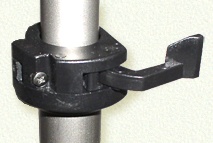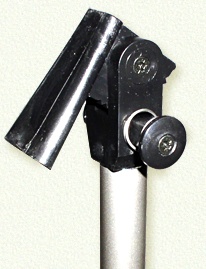Nilton collapsible desk stand
 Origin:
Sweden Origin:
Sweden
Guide price: £54.99
Weight: -
Date of manufacture: 2006
Date reviewed: September 2006
A light, robust and highly portable professional
music stand
The music stand must surely be the forgotten hero in the arsenal of accessories
that the average musician uses in a lifetime's playing.
Barely a thought is given to it as it steadfastly props up the music day
after day, gig after gig - and about the only time much attention is paid
to it is when it causes hassle...usually by falling apart or over at a
most inconvenient moment.
Stands come in all shapes and sizes, and for most people the humble wire
stand is all they'll ever need. However, working musicians are often required
to be 'presentable' on stage, and nothing looks quite so tatty as a miscellaneous
assortment of wire stands - in various colours, designs and states of
disrepair.
Also, wire stands tend to be very lightly built and the slightest knock
will often send any music placed upon it flying - and quite often the
stand too.
For these reasons many working musicians favour a beefier setup and opt
for a rather more substantial music stand - often known as a desk or conductor's
stand.
The trade-off here is that beefier stands, although being more stable
and better looking on stage, tend to be quite heavy and rather less compact
and portable than their wire siblings.
There's quite a choice of desk stands out there, most of which feature
a metal tripod base and a detachable metal desk. Such stands can be bought
for as little as £25 and all of them are more than capable of doing
the job they're designed for without too many problems at all. I say 'too
many problems' because about the only time such stands prove to be an
inconvenience is when you're shipping them in and out of the gig venue,
and setting them up.
I suspect there's many a musician out there who, being faced with a decent
walk to the venue from the car park followed by a tricky obstacle course
through the venue to the stage itself, has sighed resignedly when they
realised they'd never make it in one trip with a horn over one shoulder,
an accessory bag in one hand, a suit in the other and a bulky music stand
vying for whatever space is left - and so they faced the prospect of making
two trips.
Doesn't sound like a lot, and it isn't if you can park right outside the
venue...but two trips of 500 yards over a muddy field to a marquee, or
up half a dozen flights of steps through narrow corridors in a theatre
soon loses its appeal. And you have to do it again, twice, at the end
of the evening (and no-one ever helps a horn player heft their kit).
Once you get on stage you then have to set the stand up, and this typically
involves fiddling with various nuts, bolts and screws - usually whilst
trying to avoid knocking over any adjacent kit (particularly the guitarist's/oboist's
beer).
What's been needed for a very long time is a desk stand that is both
sturdy and presentable, yet light and compact - and also tough enough
to withstand the rigours of gigging.
Well, here it is.
The Nilton stand comes in two parts. The tripod itself is constructed
of aluminium tubing with ABS legs and clamps, and a folding desk also
made from ABS. To most people ABS is plastic, but to those in the know
ABS is a remarkably tough and flexible material that has excellent resistance
to wear and shock damage.
 The
tripod has two extension tubes built in, each of which can be locked in
position by means of a very simple but effective clip clamp, as seen on
the left in its open position - and the same type of clamp is used to
lock the tripod feet in place. These clips feature a small adjusting screw
that allows you to vary how tightly the clamps lock, though I can't see
that such an adjustment would need to be made more than a couple of times
in the stand's lifetime. The
tripod has two extension tubes built in, each of which can be locked in
position by means of a very simple but effective clip clamp, as seen on
the left in its open position - and the same type of clamp is used to
lock the tripod feet in place. These clips feature a small adjusting screw
that allows you to vary how tightly the clamps lock, though I can't see
that such an adjustment would need to be made more than a couple of times
in the stand's lifetime.
Setting up the tripod takes something in the order of ten seconds. Taking
it down takes half that.
 On
top of the tripod is the desk clip. This is a swivelling unit with a sprung
button catch that allows the desk to be angled in a variety of positions
(about a dozen in all) and fitting the desk to the clip by simply pushing
it onto the tapered mount locks the desk open. On
top of the tripod is the desk clip. This is a swivelling unit with a sprung
button catch that allows the desk to be angled in a variety of positions
(about a dozen in all) and fitting the desk to the clip by simply pushing
it onto the tapered mount locks the desk open.
The desk is hinged horizontally along its centre. It doesn't fold flat
though, because at the bottom of the desk is the shelf (which stops the
music dropping off, obviously) and below this shelf is a compartment that
comes in handy for all your on-stage knick-knacks. It's into this compartment
that the tripod fits once folded up.
This is the real beauty of this stand...with the tripod sitting snugly
in the compartment, the desk is folded and clipped shut and the whole
thing is contained in one compact unit, complete with a carrying handle.
My first concern, oddly enough, was with the lightness of the stand.
It's all good and well having a light stand, but that often points up
a lack of stability - yet this stand felt solid enough once erected. Sure,
if you knock it it will move - but it won't fall over unless you really
crash into it.
Another concern was the desk hinge. This runs across the middle of the
desk and could present some difficulties if you needed to scribble something
on your music, because Sod's law dictates that the hinge will always run
under the spot where you want to write.
Whether that's an issue for you depends on how much writing you do on
a stand - I tend to use a rollerball pen for such work, which doesn't
require any significant pressure in order to make legible marks on the
score (though people who've seen my music writing will be chuckling at
the notion of my marks being thought of as anything near legible).
I would have liked to have seen slightly beefier catches on the lid. The
catches look sturdy enough, though I wonder how well they'll stand up
to prolonged use. Should the catches fail the lid would no longer form
a secure box, and you'd lose the portability you'd paid for. That said,
I found one of those clipboard clips will do the job of clamping the lid,
and it's always worth carrying one of these around for those occasional
draughty venues...or to stop punters pinching your set list.
Similarly, the built-in handle is a simple flexible plasticky/rubber affair.
I guess doesn't have to take much weight and I gave it a very thorough
tug to see how much strain it could take, so as long as you don't fill
the stand with scrap iron and wave it around your head on a regular basis
I should imagine it will last (there goes one of my favourite pastimes...).
I like my reviews to be based on real-life use, so I used the Nilton
stand on a run of gigs to see how it would fare - and at the end of the
last test gig I set about doing stability and strength tests on the stand.
I never cease to be amazed at how helpful one's fellow musicians can be...
The keyboard player noticed me prodding and poking the stand and asked
what I was up to. I told him I was reviewing the stand and was seeing
how well it stood up to a bit of abuse, adding that I'd been told not
to go easy on it. "Oh really?" he says - and then gives the
stand a kick that sends it six feet across the floor.
Between us both we spent a very entertaining few minutes pushing and throwing
the stand this way and that, without doing any apparent damage to it.
The desk proved to be remarkably resilient, and what with the ABS being
quite flexible and the stand being very light the whole thing simply bounced
whenever it took a kicking.
Just to be on the safe side I folded the whole thing up and threw it down
a flight of stairs, which was fun. Once again, there was no damage to
the stand.
 You
might think it all sounds a bit extreme, but then you have to consider
the sort of life a music stand is likely to lead. They often live
in the boot of the car or lie in a corner where heavier items are
thrown on them. They have to endure any number of knocks; from the
musician next to you being a bit careless with his feet through
to a drunken punter falling onto the stage, and the stand, in the
hope of getting you to play 'Lady in Red' (fat chance). Through
all this the stand has to continue to function. It really is a tough
old life. You
might think it all sounds a bit extreme, but then you have to consider
the sort of life a music stand is likely to lead. They often live
in the boot of the car or lie in a corner where heavier items are
thrown on them. They have to endure any number of knocks; from the
musician next to you being a bit careless with his feet through
to a drunken punter falling onto the stage, and the stand, in the
hope of getting you to play 'Lady in Red' (fat chance). Through
all this the stand has to continue to function. It really is a tough
old life.
Consider too that the first thing anyone seeing this stand will
say is "But it's made of plastic!". That's why my tests
were particularly harsh. Worth bearing in mind too that if someone
asked me to do the same tests with my metal desk stand I reckon
I'd think twice. As of March 2014 it's been about six and a half
years since I started using this stand and it's seen a good few
gigs and rehearsals - and it's still going strong.
In the event of a catastrophe you wouldn't necessarily need to buy a whole
new stand - the desk is available as a spare part and, logically enough,
so is the tripod.
I tried a clip-on light with the stand too, and noted no problems with
stability.
I didn't try fitting my beer glass holder to the stand. This highly useful,
nay essential, accessory is a spin-off from a brass player's mute holder
- which is attached to the tripod pole and provides somewhere safe and
convenient to store a mute...or in my case a pint of beer. What with a
pint of beer being quite weighty, the beer glass holder has a clamp that
has to be screwed to the tripod...and I think this would be asking a bit
too much of the aluminium tube. It would also knacker the portability,
given that the stand wouldn't fold up with the holder attached.
In terms of the competition there are least a couple of other stands
out there which are more collapsible than ordinary desk stands, but none
are as self-contained as the Nilton - nor as flexible and user-friendly.
They're cheaper though, but in my experience 'half the convenience' is
seldom worth the money saved.
There are a few optional extras available. Most useful is a shoulder
bag (about £10) - big enough to take the folded stand and a few
extra items. There's also a ballast weight available. This slips onto
the tripod base and adds a bit of stability should you ever need it -
though I've only ever used mine on outdoor gigs.
You can also purchase rather snazzy music clips, made in clear plastic...so
no matter where you clip them on the music, you can always read the dots.
Neat idea.
|



